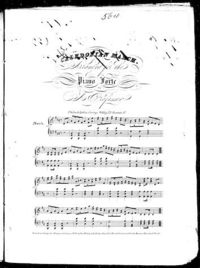Annotation:Caledonian March (1): Difference between revisions
No edit summary |
m (Text replacement - "garamond, serif" to "sans-serif") |
||
| (7 intermediate revisions by one other user not shown) | |||
| Line 1: | Line 1: | ||
'''Back to [[{{BASEPAGENAME}}]]''' | =='''Back to [[{{BASEPAGENAME}}]]'''== | ||
---- | ---- | ||
<p><font face=" | <p><font face="sans-serif" size="4"> | ||
'''CALEDONIAN MARCH'''. AKA and see "Bonaparte Crossing the Rhine | '''CALEDONIAN MARCH [1]'''. AKA and see "[[Bonaparte Crossing the Rhine (1)]]," "[[Star of Bethlehem]]" (Pa.). Scottish, March (4/4 time). D Major. Standard tuning (fiddle). AABB. The march appears (under the 'Caledonian' title) in several of Boston music publisher Elias Howe's publications, including his '''Musician's Companion''' of 1842, whose contents were arranged by members of the Boston Brigade Band, a very popular and accomplished brass band. However, the earliest publication found to date is by Philadelphia music publisher George Willig, who issued it on a single sheet in 1837, arranged by "A professor". | ||
[[File:caledonian.jpg|200px|thumb|left|Willig's "Caledonian March"]] | |||
<br> | |||
<br> | |||
See also Bayard's (1981) note for "[[Dusinberry March (The)]]" and the "[[Star of Bethlehem]]," both closely related Pennsylvania collected marches. See also the Irish tunes "[[Comhra Donn (An)]]" and "[[Centenary March (The)]]," melodically similar in the 'A' part. | |||
<br> | <br> | ||
<br> | <br> | ||
</font></p> | </font></p> | ||
<p><font face=" | <p><font face="sans-serif" size="4"> | ||
''Source for notated version'': | ''Source for notated version'': | ||
<br> | <br> | ||
<br> | <br> | ||
</font></p> | </font></p> | ||
<p><font face=" | <p><font face="sans-serif" size="4"> | ||
''Printed sources'': Howe ('''Musician's Companion'''), 1842; p. 17. Howe ('''School for the Violin'''), p. 17. Kerr ('''Merry Melodies'''), vol. 1; No. 27, p. 49 | ''Printed sources'': Howe ('''Musician's Companion'''), 1842; p. 17. Howe ('''School for the Violin'''), p. 17. Kerr ('''Merry Melodies'''), vol. 1; No. 27, p. 49. | ||
<br> | <br> | ||
<br> | <br> | ||
</font></p> | </font></p> | ||
<p><font face=" | <p><font face="sans-serif" size="4"> | ||
''Recorded sources'': <font color=teal>Greentrax CDTRAX 9009, Pat Shearer (Orkney Islands) - "Scottish Tradition 9: The Fiddler and his Art" (1993).</font> | ''Recorded sources'': <font color=teal>Greentrax CDTRAX 9009, Pat Shearer (Orkney Islands) - "Scottish Tradition 9: The Fiddler and his Art" (1993).</font> | ||
</font></p> | </font></p> | ||
| Line 22: | Line 26: | ||
<br> | <br> | ||
---- | ---- | ||
'''Back to [[{{BASEPAGENAME}}]]''' | =='''Back to [[{{BASEPAGENAME}}]]'''== | ||
Latest revision as of 11:53, 6 May 2019
Back to Caledonian March (1)
CALEDONIAN MARCH [1]. AKA and see "Bonaparte Crossing the Rhine (1)," "Star of Bethlehem" (Pa.). Scottish, March (4/4 time). D Major. Standard tuning (fiddle). AABB. The march appears (under the 'Caledonian' title) in several of Boston music publisher Elias Howe's publications, including his Musician's Companion of 1842, whose contents were arranged by members of the Boston Brigade Band, a very popular and accomplished brass band. However, the earliest publication found to date is by Philadelphia music publisher George Willig, who issued it on a single sheet in 1837, arranged by "A professor".

See also Bayard's (1981) note for "Dusinberry March (The)" and the "Star of Bethlehem," both closely related Pennsylvania collected marches. See also the Irish tunes "Comhra Donn (An)" and "Centenary March (The)," melodically similar in the 'A' part.
Source for notated version:
Printed sources: Howe (Musician's Companion), 1842; p. 17. Howe (School for the Violin), p. 17. Kerr (Merry Melodies), vol. 1; No. 27, p. 49.
Recorded sources: Greentrax CDTRAX 9009, Pat Shearer (Orkney Islands) - "Scottish Tradition 9: The Fiddler and his Art" (1993).
